
25
Salon de Montrouge: who are the new talents who are electrifying contemporary art?
On 22 October, the Salon de Montrouge inaugurated its 65th edition in the heart of the city’s Belfry. Postponed by a year due to the pandemic, it brings together until October 31 fifty young French artists or artists linked to France, each presenting their own space to give a new insight into their practice. Between digital sexuality, post-colonial issues , synthetic drugs and addictive videos, discover the themes and practices that drive seven talents spotted in this new edition.
Published on October 25, 2021. Updated on May 31, 2024.
Pierre Pauze
Many videographers have depicted the effects of psychotropic drugs, including the ecstasy caused by recreational drugs consumed at festive parties. Pierre Pauze pushes this ambition a step further: in his Please Love Party, in 2018, the French artist imagined, with the help of a laboratory, synthetic products based on hormones related to love. From the backstage of the manufacture of this new substance to its final use by twenty people invited to test it together in a club-like set-up, his film makes the viewer sway between the luminous and clinical aesthetics of the laboratory and the dark and stroboscopic aesthetic of the party. In Montrouge, this film on the borders of behavioural study appears in an installation full of hallucinatory colours, which plunges the viewer into the centre of strange visions of thermal cameras printed on carpets and cushions. At their side, the artist presents the bottle that contained, during the shooting, the mysterious drug that the twenty guinea pigs tested…
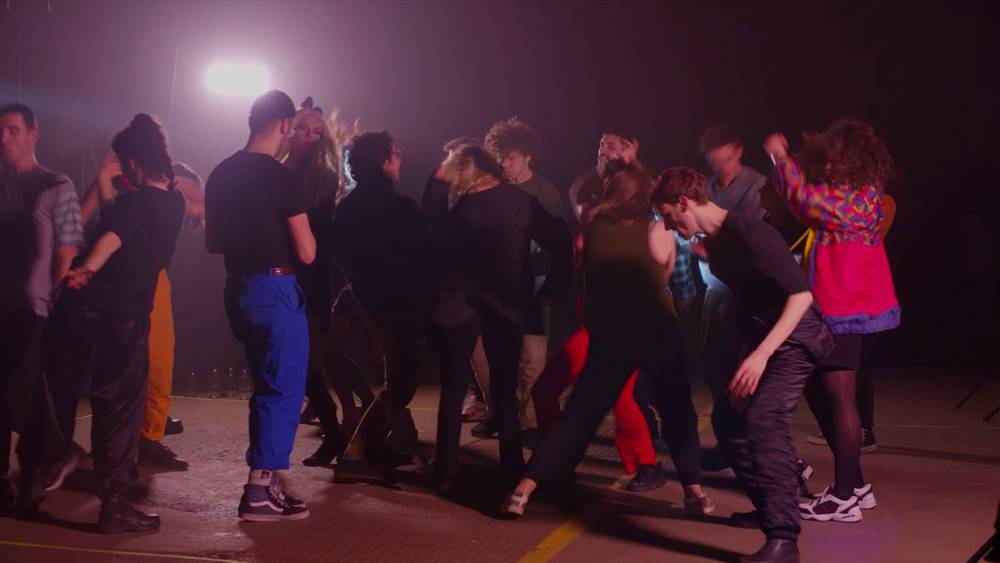
Lívia Melzi
On a blue carpet, a table is set in the French style: stemmed glasses, candles, silverware, everything is gathered to accommodate four guests, right down to the large black and white tapestry hanging behind it, which decorates the prandial scene. But the illustration on this fabric reveals a much less reassuring image, where naked men and women indulge in a cannibalistic meal. Thus, when we look at the contents of this table, we imagine blood in the burgundy liquid contained in the glasses, and we recognize human guts in the immaculate white casts present on the plates. Lívia Melzi’s installation hits hard. The Brazilian-born artist, who is also a doctoral student in the anthropology of language, has been pursuing a quest for years on the first peoples of her country of birth and their representations in the West. The enlarged scene on the tapestry is based on a sixteenth-century European engraving offering a frightening and largely caricatured vision of their way of life. As for the photograph hanging on the wall, it presents a sacred cloak of the indigenous people, the Tupinambá, of which the artist tries to find, inventory and photograph the few remaining copies, all scattered in Western collections, to recontextualize their role in Brazilian rituals. This is a powerful approach at a time when debates are being held on the restitution of works of art and historical objects to the colonized countries where they were born. Winner of the Grand Prix of the Salon this year, Lívia Melzi will present a solo exhibition at the Palais de Tokyo next year.
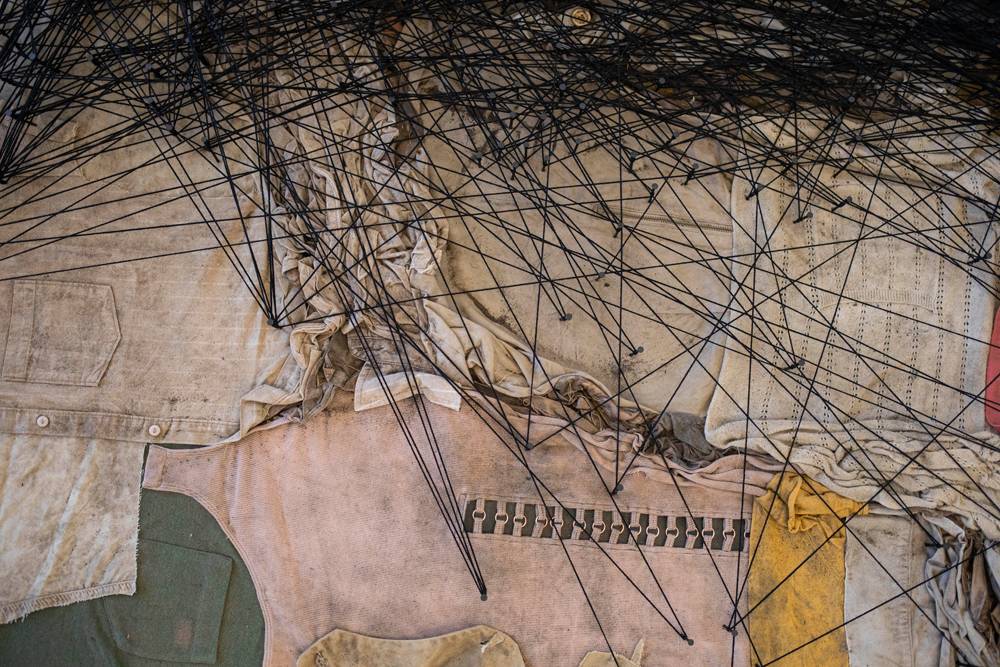
Segondurante
On the evening of the opening of the Salon de Montrouge, Hugo Durante and Guillaume Segond, two halves of the Segondurante duo , wanted to organize a joyful barbecue. At the top of A few Dressed stone blocks, reworked to accommodate railings, the duo brought a few ears of corn to bring out the conviviality in the these ruins and free themselves from their romantic connotation. The theme of fire continues in the ceramics of the two visual artists, both sculptors by training. One, presented in a gilded frame, consists of six panels assembled to form a painting on which the black skeleton of a snake is drawn. The other depicts a pair of flaming boots with protruding toes. With these works, Segondurante questions the uses of stone and mixes archaic shapes and patterns with the seductive codes of fashion, pop culture and, of course, contemporary art. Their installation is called “Daniel”, a tribute to the British artist Daniel Dewar who, with Grégory Gicquel, also forms a duo of sculptors accustomed to having fun with the paragons of art and its history.
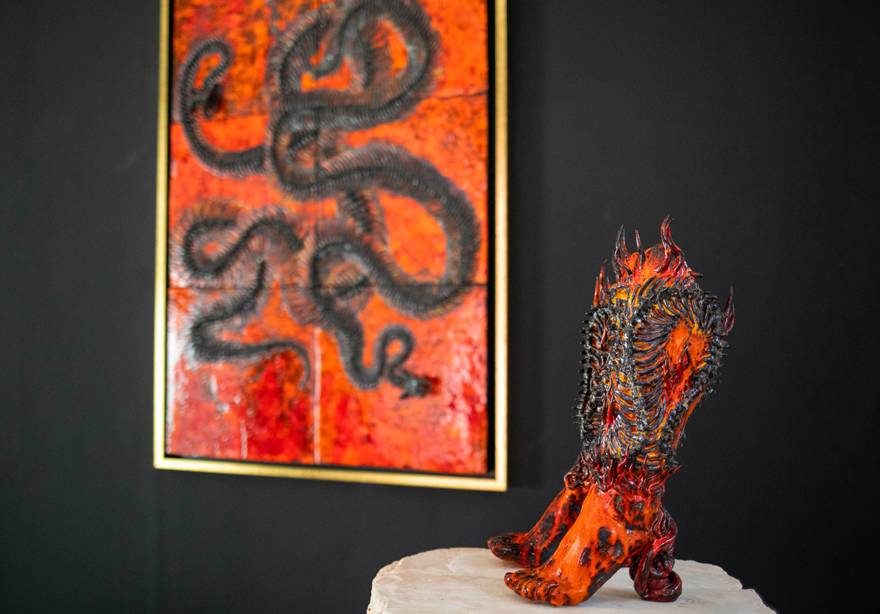
Camila Rodríguez Triana
For Camila Rodríguez Triana, the duty of remembrance is essential, and art must echo this. The young woman deals in particular with her country of origin, Colombia, whose political situation she has been following closely since the peace agreement signed in 2016 between the government and the FARC (Revolutionary Armed Forces of Colombia). Anxious to recall the immense human damage caused by this war over nearly six decades, the artist crisscrossed the country to meet the families of war victims whose murderers remain unknown to this day, recovering their clothes and personal objects. On the ground, on a support in the shape of the country, she assembles fragments of these clothes and marks, with lead nails, the precise places where these men and women were killed. Like the dark weft of a spider’s web, black threads are stretched between these nails and crawl on the walls to the enclosures which, high up, proclaim the names of these victims. A true memorial cartography, this new installation evokes a subject that is still taboo in Colombia today, where presenting it would still be impossible today due to censorship.
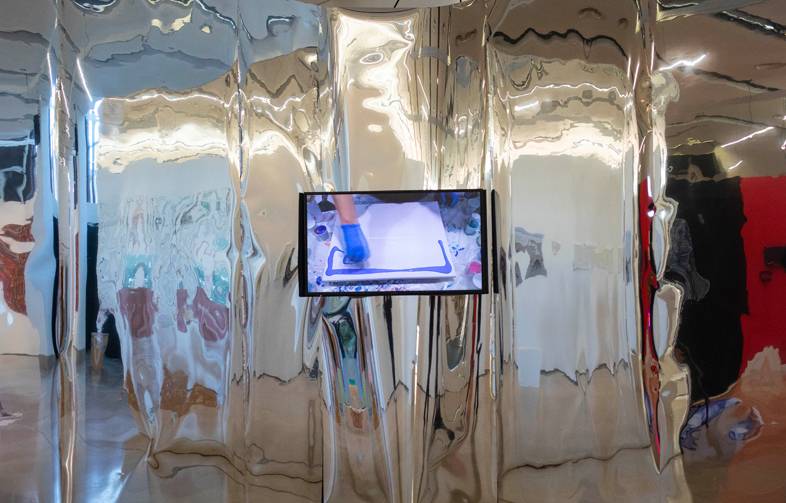
Yuyan Wang
The lockdown has given rise to many obsessions. During this strange time, Yuyan Wang spent hours in front of visually comforting videos, found on Youtube and other social networks: some dewdrops beading on flower petals, one kneaded viscous material obstinately a smartphone screen that has been shredded, but also Videos reviewed by whispered voices near the microphone, following the trend of ASMR which plunges the viewer into a very particular emotional state. In her film, the French artist of Chinese origin brings together dozens of them in a fast, jerky and frenetic edit, accompanied by unintelligible voices that make up a haunting loop. At the center of his selection is the ability to “become the ocean”, an allegory of the liquidity of images in a society of extreme visual consumption. A project in the tradition of Rachel Rose’s immersive videos where digital content, originally appreciated for its pure aesthetic qualities, ends up saying much more than it seems.
65th Salon de Montrouge, until 31 October at the Belfry of Montrouge.
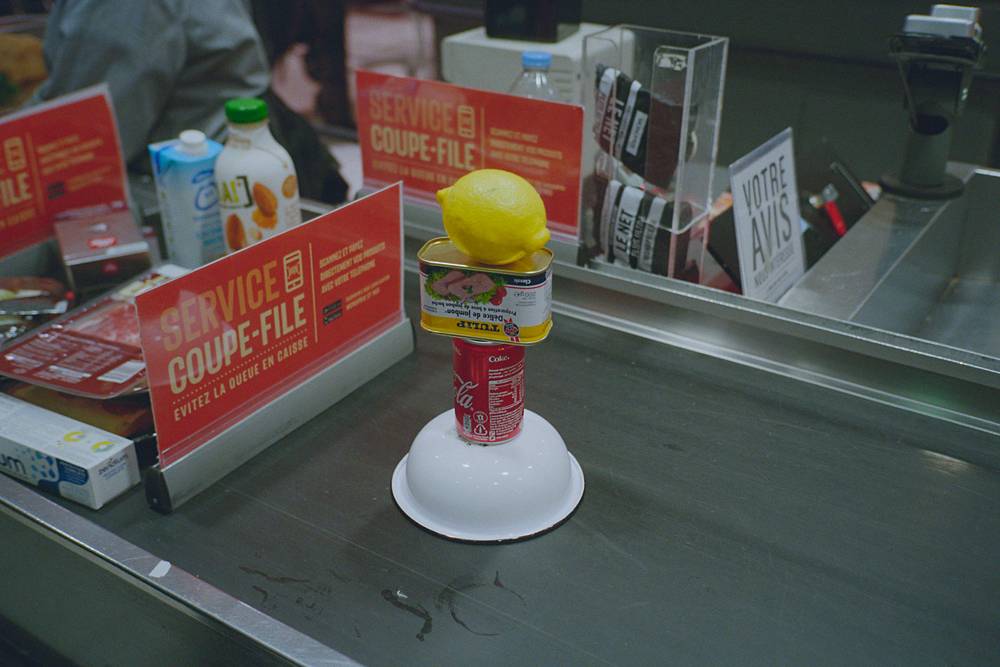
Yue Yuan
The performances particularly fascinate Yue Yan… But not just any performances : the everyday performances made by ordinary heroes, whose poetic potential the young Parisian artist strives to reveal. It is therefore in the most banal settings that his practice flourishes. On the conveyor belts of a supermarket checkout, the thirty-year-old composes, from the products chosen from the shelves, ephemeral sculptures of which only the cashiers are spectators. At Saint-Denis, he photographed his hand moving a lemon from one display to another. In Rome, he borrowed a coin, thrown into the Trevi Fountain, to put it in a plastic bottle, now in Montrouge. In a park, he returns, one by one, dead leaves under a tree… At the Salon, the mischievous artist presents his tender misdeeds on the front pages of newspapers he publishes himself, even going so far as to offer visitors a list of actions to take in his exhibitions, such as changing the Wi-Fi password or stealing shoes. A way of diverting the serious conventions of artistic spaces to make it a playground, where the public becomes his accomplice.
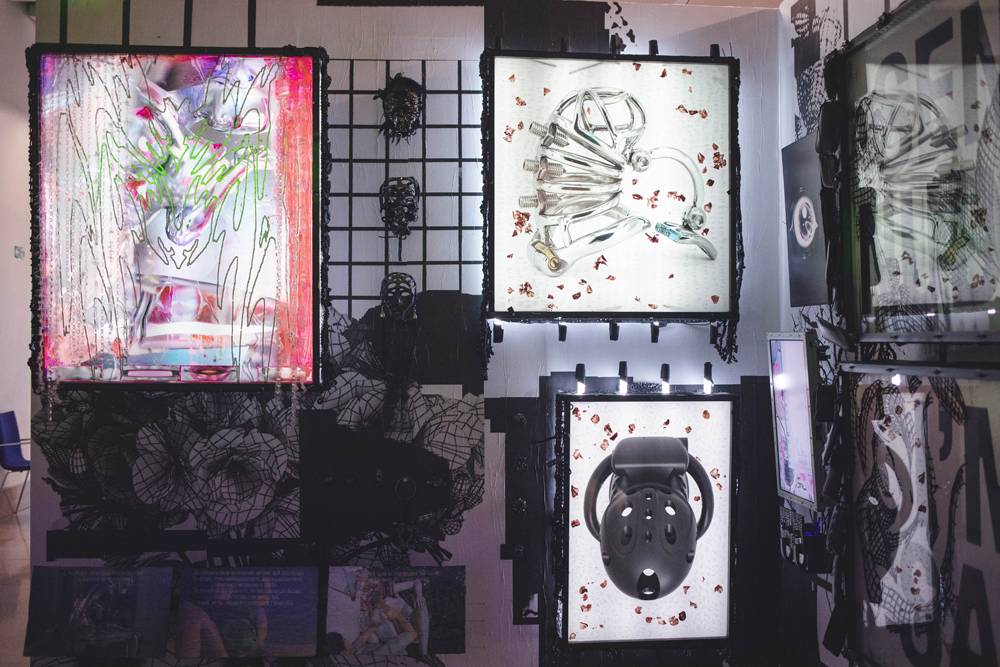
Thomas Guillemet
Thomas Guillemet’s gaze is riveted as much on the meanders of the darknet as on new behaviors in companies. The analogy between these two worlds ? The mutation some modes of communication and performance criteria, but also the virtualization of desire and its artefacts through the hours spent behind our screens, to be consumed without touching. The installation that the artist proposes in Montrouge is the reflection of this density :one y finds, pell-mell, luminous screens showing images of chastity cages or catchphrases typical of online forums : “Send Nudes”, “I’m sad”, screenshots of pornographic films featuring robots, garlands of plastic false nails reminiscent of those of escort girls, or ceramic masks decorated with harnesses inspired by BDSM role-playing. A jack-of-all-trades, the artist invests sculpture as well as 3D images or computer code to compose his multimedia ensembles : in Montrouge, visitors are even invited to contact a telephone number to receive a surprising image… From this proliferation, as animated as it may be, emerge questions about the new languages and new codes used in these universes where desire is lost in unbridled consumerism, finally revealing the human being in his great vulnerability.
















